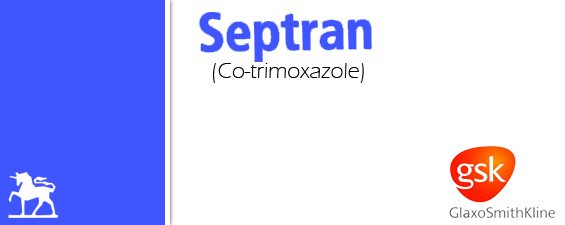- Septran Tablet contains
Sulfamethoxazole 400mg
Trimethoprim 80mg - Septran Suspension contains
Sulfamethoxazole 200mg/5ml
Trimethoprim 40mg/5ml - Septran DS Tablets contains
Sulfamethoxazole 800mg
Trimethoprim 160mg - Septran DS Suspension contains
Sulfamethoxazole 400mg/5ml
Trimethoprim 80mg/5ml
What is Septran Used For?
Septran is not indicated for prophylactic or prolonged administration.
Septran is used for the treatment of Otitis Media, Acute exacerbations of chronic bronchitis, Acute uncomplicated UTI, Gonorrhea, Oropharyngeal & anorectal infections, chancroid and granuloma inguinal (venereum).
Gastro-intestinal Tract Infection: First line therapy in the management of all patients with diarrheal disease is the maintenance of adequate hydration. In cholera, as an adjunct to fluid and electrolyte replacement, shigellosis and Traveler’s diarrhea (including gastroenteritis due to enterotoxigenic E. coli.
The use of Septran in number of other bacterial infections caused by sensitive organisms should be based on clinical experience and local data. The susceptibility of bacteria to antibiotics varies geographically and with time, the local situation should always be considered when selecting an antibiotic therapy.
When to avoid Septran Tablets & Suspension?
Septran should not be given to patients with a history of hypersensitivity to sulphonamides, trimethoprim or Co-trimoxazole, patients with serious hematological disorder, premature babies and to full-term infants in the neonatal period.
Drug Warnings & Precautions
Fatalities, though rare have occurred due to severe reactions including Stevens- Johnson syndrome, Lyell syndrome (toxic epidermal necrolysis), fulminant hepatic necrosis, agranulocytosis, aplastic anemia and other blood dyscrasias and hypersensitivity of respiratory tract.
Septran should be discontinued at first appearance of skin rash. An adequate urinary output should be maintained at all times. For patients with known renal impairment special measures should be adopted. Exercise caution when treating patients with severe hepatic parenchymal damage. Regular monthly blood counts are advisable when Septran is given for long periods. Septran should be given with caution to patients with severe allergy or bronchial asthma.
Septran during Pregnancy & Lactation
The safety of Septran in human pregnancy has not been established. Despite the excretion of trimethoprim and sulfamethoxazole into breast milk the administration of Septran to lactating women represents a negligible risk to suckling infant.
Possible Side Effects of Septran
As Septran contains trimethoprim and Sulfamethoxazole, the type and frequency of side effects associated with such compounds may be expected. At the recommended dosages, Septran is usually well tolerated.
More severe skin sensitivity reactions such as exfoliative dermatitis, erythema multiforme bullosa (Steven-Johnson syndrome) and toxic epidermal necrolysis (Lyell syndrome) have occurred rarely. The latter condition carries a high mortality. Hematological changes have been reported, the majority being mild and reversible when treatment was stopped.
The changes are mainly leucopenia, neutropenia, thrombocytopenia and less commonly, agranulocytosis, megaloblastic anemia, aplastic anemia, hemolytic anemia and methemoglobinemia.
Although most of the changes cause no clinical symptoms, they may become severe in isolated cases especially in the elderly, in those with hepatic or renal dysfunction or in those with poor folate status. At the high dosages used for the therapy of Pneumocystic carinii pneumonitis in patients with acquired immune deficiency syndrome (AIDS), rash fever, hyponatremia have been reported.

Leave A Comment